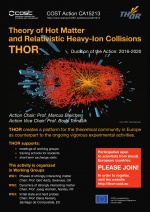Difference between revisions of "Main Page"
| (8 intermediate revisions by the same user not shown) | |||
| Line 1: | Line 1: | ||
| − | == | + | |
| + | == Summary of CA15213 Theory of hot matter and relativistic heavy-ion collisions == | ||
| + | |||
[[File:Logo01.jpg|200 px|left]] | [[File:Logo01.jpg|200 px|left]] | ||
[[File:THOR poster print c.jpg|150 px|right]] | [[File:THOR poster print c.jpg|150 px|right]] | ||
| − | + | Matter under extreme conditions in terms of temperature and density, as in the early Universe or in compact stellar objects (e.g. neutron stars) can be created and studied with the help of relativistic heavy ion collisions. Scientifically, the main aim is to explore and reconstruct the matter’s transport properties, phase structure, in-medium properties of hadrons and active degrees of freedom of Quantum Chromodynamics (QCD) from the experimental measurements of individual quantities. While the experimental activities are organised and optimised in large international collaborations, there is no such structure for theoretical activities. | |
| + | |||
| + | The proposed COST Action “Theory of hot matter and relativistic heavy-ion collisions” (THOR) creates a theoretical community platform as counterpart to the ongoing vigorous experimental activities. THOR will for the first time allow to fully exploit Europe’s exceptional potential in this field of theoretical research. THOR will pioneer novel approaches to the theoretical understanding of the properties of QCD from first principles and on the interpretations of these properties by effective models and numerical simulations of the system’s evolution. By this, THOR will provide new insights on the paramount questions of the field. Therefore THOR aims at bringing together excellent researchers in order to pinpoint and discuss the challenges that the field meets currently and in the near future for creating a vibrant, innovative and world- leading pan-European research environment. | ||
| − | + | From this page one can continue to pages which discuss specific topics: | |
| + | = Strongly interacting matter = | ||
| + | * [[Lattice QCD]] | ||
| + | * [[Effective theories]] | ||
| + | * [[Equation of State]] | ||
| + | * [[Phase diagram]] | ||
| + | * [[Fluctuations of conserved charges]] | ||
| + | * [[Transport coefficients]] | ||
| + | * [[Statistical model]] | ||
| − | + | =Dynamics of heavy-ion collisions= | |
| + | * [[Glauber model]] | ||
| + | * [[Parton distribution functions]] | ||
| + | * [[Hydrodynamics]] | ||
| + | * [[Transport models]] | ||
| + | * [[Collective expansion]] | ||
| + | * [[Femtoscopy]] | ||
| + | * [[Baryon number fluctuations]] | ||
| + | * [[Strangeness production]] | ||
| + | * [[Heavy quarks]] | ||
| + | * [[Jets]] | ||
| + | * [[Parton energy loss]] | ||
Latest revision as of 21:38, 29 October 2018
Contents
Summary of CA15213 Theory of hot matter and relativistic heavy-ion collisions
Matter under extreme conditions in terms of temperature and density, as in the early Universe or in compact stellar objects (e.g. neutron stars) can be created and studied with the help of relativistic heavy ion collisions. Scientifically, the main aim is to explore and reconstruct the matter’s transport properties, phase structure, in-medium properties of hadrons and active degrees of freedom of Quantum Chromodynamics (QCD) from the experimental measurements of individual quantities. While the experimental activities are organised and optimised in large international collaborations, there is no such structure for theoretical activities.
The proposed COST Action “Theory of hot matter and relativistic heavy-ion collisions” (THOR) creates a theoretical community platform as counterpart to the ongoing vigorous experimental activities. THOR will for the first time allow to fully exploit Europe’s exceptional potential in this field of theoretical research. THOR will pioneer novel approaches to the theoretical understanding of the properties of QCD from first principles and on the interpretations of these properties by effective models and numerical simulations of the system’s evolution. By this, THOR will provide new insights on the paramount questions of the field. Therefore THOR aims at bringing together excellent researchers in order to pinpoint and discuss the challenges that the field meets currently and in the near future for creating a vibrant, innovative and world- leading pan-European research environment.
From this page one can continue to pages which discuss specific topics:
Strongly interacting matter
- Lattice QCD
- Effective theories
- Equation of State
- Phase diagram
- Fluctuations of conserved charges
- Transport coefficients
- Statistical model
Dynamics of heavy-ion collisions
- Glauber model
- Parton distribution functions
- Hydrodynamics
- Transport models
- Collective expansion
- Femtoscopy
- Baryon number fluctuations
- Strangeness production
- Heavy quarks
- Jets
- Parton energy loss
Consult the User's Guide for information on using the wiki software.

